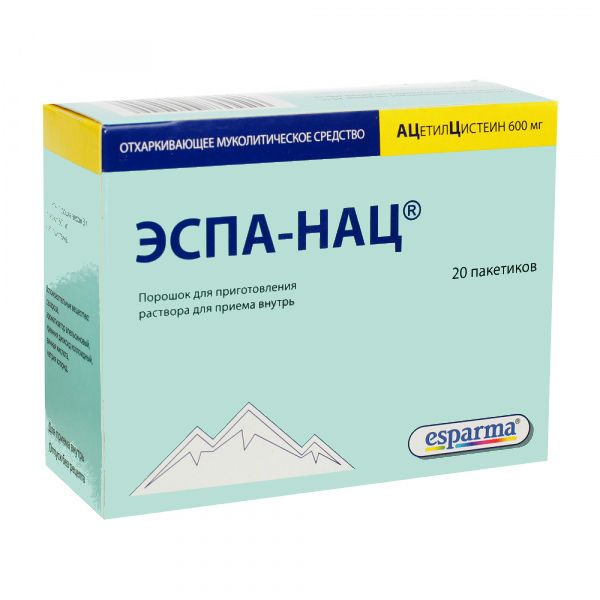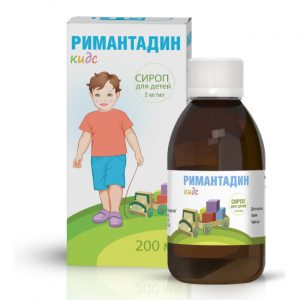Description
Description
Homogeneous powder of white or almost white color, without agglomerates and foreign particles, with a fruity odor.
Pharmacological action
Mucolytic agent, dilutes sputum, increases its volume, facilitates sputum discharge. The action is associated with the ability of the free sulfhydryl groups of acetylcysteine to break the intra- and intermolecular disulfide bonds of mucopolysaccharide chains, which leads to the depolymerization of mucoproteins and a decrease in the viscosity of sputum (in some cases this leads to a significant increase in sputum volume, which requires aspiration of the contents of the bronchi). It remains active with purulent sputum. Does not affect immunity.
Increases the secretion of less viscous sialomucins by goblet cells, reduces the adhesion of bacteria on the epithelial cells of the bronchial mucosa.
Stimulates mucous cells of the bronchi, the secret of which lyse fibrin.
has a similar effect on a secret, formed in inflammatory diseases of ENT organs.
It has an antioxidant effect due to the presence of an SH group capable of neutralizing electrophilic oxidative toxins.
Protects alpha-1-antitrypsin (an elastase inhibitor) from the inactivating effect of HOC1, an oxidizing agent produced by myeloperoxidase active phagocytes.
It also has some anti-inflammatory effect (due to the suppression of the formation of free radicals and active oxygen-containing substances responsible for the development of inflammation in the lung tissue).
Leads to increased glutathione synthesis, which explains the detoxifying effect of paracetamol poisoning.
With the prophylactic use of acetylcysteine, there is a decrease in the frequency and severity of exacerbations in patients with chronic bronchitis and cystic fibrosis.
Indications
Diseases of the respiratory system, accompanied by the formation of viscous difficult to separate sputum:
– acute and chronic bronchitis, obstructive bronchitis
– tracheitis, laryngotracheitis
– pneumonia
– bronchiectasis, bronchial asthma, chronic obstructive pulmonary disease (COPD), bronchiolitis
– cystic fibrosis.
Acute and chronic sinusitis, inflammation of the middle ear (otitis media).
Contraindications
– Hypersensitivity to acetylcysteine or other components of the
preparation – gastric and duodenal ulcer in the acute stage
– hemoptysis, pulmonary hemorrhage
– glucose malignancy, glucose malignancy, glucose malignancy, – pregnancy
– lactation period
– children under 14 years of age (for a dosage of 600 mg), children under 2 years of age (for a dosage of 200 mg).
With caution: a history of gastric and duodenal ulcer, varicose veins of the esophagus, bronchial asthma, obstructive bronchitis, adrenal disease, hepatic and / or renal failure, arterial hypertension, histamine intolerance (long-term use of the drug should be avoided, since acetylcysteine affects the metabolism of histamine and can lead to signs of intolerance, such as headache, vasomotor rhinitis, itching).
Recommended use for
Unless otherwise specified, the following recommendations should be followed. The powder is dissolved in 1 cup of hot water, taken orally after a meal.
ESPA-NAC ® in a dosage of 600 mg:
Adults and children over 14 years of age: 1 time per day, 1 sachet (600 mg).
For cystic fibrosis:
Children over 6 years: 1 packet per day (600 mg).
The additional intake of fluid enhances the mucolytic effect of the drug.
For short-term colds, the duration of administration is 5-7 days. In chronic bronchitis and cystic fibrosis, the drug should be taken for a longer time to prevent infections. With long-term illnesses, the duration of therapy is determined by the attending physician.
Special instructions
For patients with asthma and obstructive bronchitis, acetylcysteine should be prescribed with caution under the systematic control of bronchial obstruction.
When dissolving the drug, it is necessary to use glassware, avoid contact with metals, rubber (sulfides with a characteristic odor are formed upon contact), oxygen, and easily oxidized substances.
When treating patients with diabetes mellitus, it must be taken into account that the preparation contains sucrose (in one 200/600 mg sachet contains 0.23 / 0.20 XE, respectively).
In patients with severe skin lesions – Stevens-Johnson syndrome or Lyell syndrome – temperature, body pain, rhinitis, cough, and sore throat may appear in the early phase. With symptomatic treatment, erroneous administration of mucolytic agents is possible. There are isolated reports (<1/10000) about the identification of Stevens-Johnson syndrome and Lyell syndrome, which coincided in time with the appointment of the drug, however, there is no causal relationship with the drug. With the development of the above syndromes (the sudden appearance of a rash and spots on the face and body, which can later spread to other parts of the body), it is recommended to stop treatment and immediately seek medical help. Impact on the ability to drive transp. Wed and fur .: At therapeutic doses does not affect the ability to drive vehicles and mechanisms. Composition 1 sachet contains: active substance: acetylcysteine ² ¹ ² ¹- 600.0 mg excipients: sucrose – 2344.10 mg, orange flavor – 50.0 mg, colloidal silicon dioxide – 3.00 mg, tartaric acid – 2 , 00 mg, sodium chloride – 0.90 mg. Side effects According to the World Health Organization (WHO), adverse effects are classified according to their frequency of development as follows: very often (? 1/10), often (? 1/100, <1/10), infrequently (? 1/1000, <1/100), rarely (? 1/10000, <1/1000) and very rarely (<1/10000) the frequency is unknown (the frequency of occurrence of phenomena cannot be determined based on available data). From the cardiovascular system: rarely – a decrease in blood pressure, an increase in heart rate (tachycardia). From the respiratory system: is very rare – the development of pulmonary hemorrhage, as a manifestation of a hypersensitivity reaction. Allergic reactions: rarely – bronchospasm (mainly in patients with a hyperreactive bronchial system with asthma), skin rash, itching and urticaria, exanthema, angioedema very rarely – anaphylactic reactions up to the development of anaphylactic shock, Stevens-Johnson syndrome, toxic epidermal. From the gastrointestinal tract: rarely – stomatitis, abdominal pain, nausea, vomiting and diarrhea, heartburn, dyspepsia. From the sensory organs: infrequently – tinnitus. Other: rarely – headache, fever, isolated reports of the development of bleeding due to the presence of hypersensitivity reactions, decreased platelet aggregation. Drug interaction With the simultaneous use of acetylcysteine and antitussive agents, mucus congestion may occur due to suppression of the cough reflex. The simultaneous administration of acetylcysteine with vasodilating agents and nitroglycerin can lead to an increase in the vasodilating effect of the latter. Pharmaceutically incompatible with antibiotics (penicillins, cephalosporins, erythromycin, tetracycline and amphotericin B) and proteolytic enzymes. Reduces the absorption of penicillins, cephalosporins, tetracycline (they should be taken no earlier than 2 hours after ingestion of acetylcysteine). Overdose of With oral administration of acetylcysteine for three months in a daily dose of up to 11.6 g, no life-threatening side effects were detected. With oral administration of acetylcysteine at a dose of up to 500 mg / kg of body weight, no poisoning phenomena were observed. Symptoms: heartburn and nausea, vomiting, diarrhea, stomach pain. In newborns, there is a risk of hypersecretion. Treatment: symptomatic. Storage conditions At a temperature not exceeding 25 ° C. Keep out of the reach of children. Expiration 4 years. Do not use after the expiry date. Form of Treatment poroshok dlya accepts vnutry




